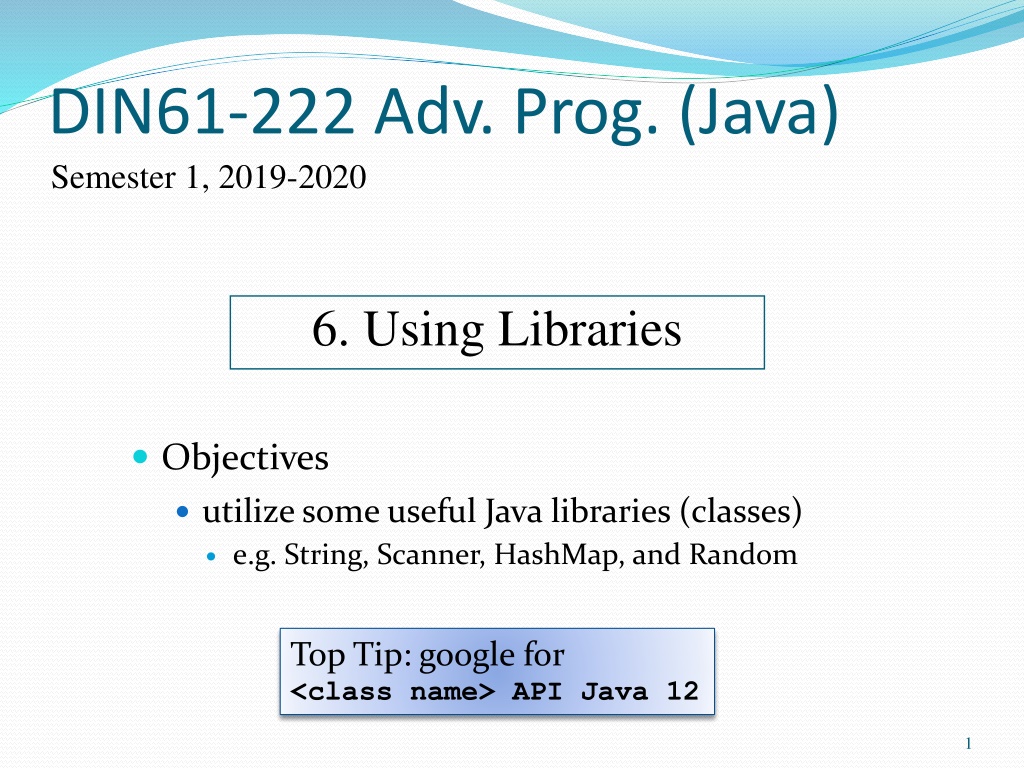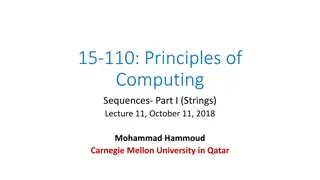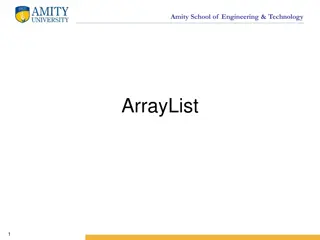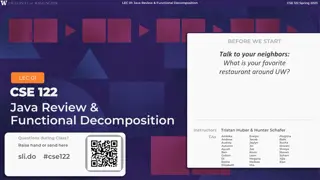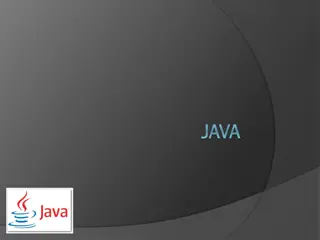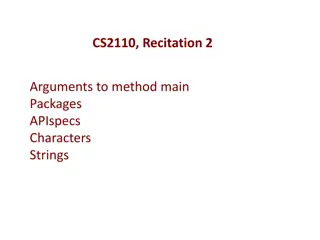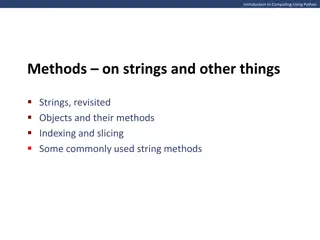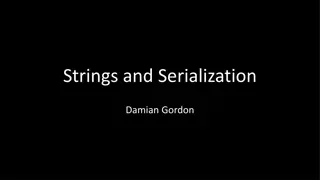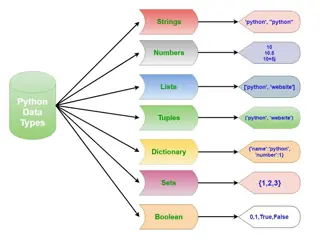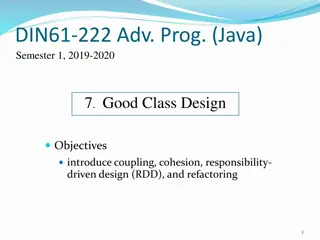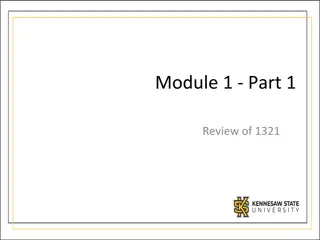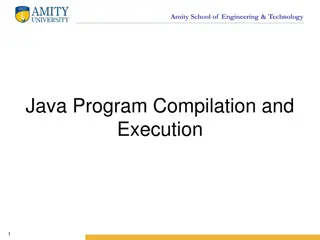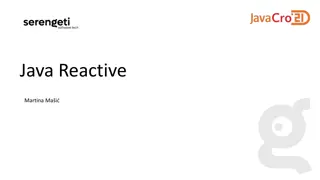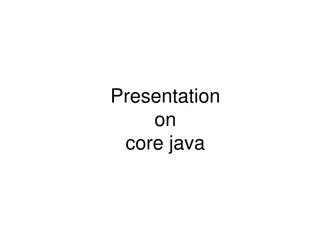Exploring String Manipulation in Java with Useful Libraries
"Delve into the world of Java programming by utilizing essential libraries such as String, Scanner, HashMap, and Random. Learn different ways to create String objects, test for equality, compare strings, locate elements, extract substrings, and modify strings effectively. Enhance your understanding of Java programming with practical examples and tips for efficient string handling."
Download Presentation

Please find below an Image/Link to download the presentation.
The content on the website is provided AS IS for your information and personal use only. It may not be sold, licensed, or shared on other websites without obtaining consent from the author. Download presentation by click this link. If you encounter any issues during the download, it is possible that the publisher has removed the file from their server.
E N D
Presentation Transcript
DIN61-222 Adv. Prog. (Java) Semester 1, 2019-2020 6. Using Libraries Objectives utilize some useful Java libraries (classes) e.g. String, Scanner, HashMap, and Random Top Tip: google for <class name> API Java 12 1
1. Creating a String Object Four different ways (there are more). 1 String color = "blue"; s1 2 String s1 = new String("hello "); "hello " char chs[] = { a , n , d , y }; String s2 = new String(chs); 3 4 String s3 = s1 + s2 + " davison"; // + is string concatenation 2
Testing Strings for Equality s1.equals(s2) lexicographical (dictionary) comparison returns true if s1 and s2 contain the same text s1 == s2 returns true if s1 and s2 reference the same object Strings should always be compared withequals() continued 3
t1 "foo" t2 String t1 = "foo"; String t2 = "foo"; "foo" t1 == t2 returns false since t1 and t2 are different objects t1.equals(t2) returns true since t1 and t2 contain the same text 4
Comparing Strings s1.compareTo(s2) returns 0 if s1 and s2 are equal returns < 0 if s1 < s2; > 0 if s1 > s2 s1.startsWith("text") returns true if s1 starts with text s1.endsWith("text") returns true if s1 ends with text 5
Locating Things in Strings for text analysis s1.indexOf('c') returns index position of first c in s1, otherwise -1 s1.lastIndexOf('c') returns index position of last c in s1, otherwise -1 Both of these can also take string arguments: s1.indexOf("text") 6
Extracting Substrings s1.substring(5) returns the substring starting at index position 5 s1.substring(1, 4) returns substring between positions 1 and 3 note: second argument is end position + 1 7
Changing Strings s1.replace('a', 'd') return new String object; replace every a by d s1.toLowerCase() return new String object where every char has been converted to lowercase s1.trim() return new String object where any white space before or after the s1 text has been removed 8
Example s "HELLO" String s = "HELLO"; s.toLowerCase(); System.out.println(s); // HELLO String s1 = s.toLowerCase(); System.out.println(s1); // hello s = s.toLowerCase(); System.out.println(s); // hello 9
Other String Methods There are many more String methods! e.g. s.length() Look at the Java documentation for the String class. Google for "String API Java 12" 10
Strings and Arrays String[] msgs = new String[4]; msgs[0] = "hello"; msgs[1] = new String("hi"); What is built? String t = msgs[1]; t.toLowerCase(); msgs[1].toLowerCase(); t = msgs[1].toLowerCase(); What is changed? 12
Objects Diagram Array Object 2 3 msgs 1 0 t "hello" String objects "hi" 13
2. Reading Input with Scanner The Scannerclass reads tokens (words) from an input stream. The input is broken into tokens based on spaces the token separator can be changed The tokens are usual read in as Strings or primitive types (e.g. int, float, char, double, boolean). 14
Read an Integer from the Keyboard Scanner sc = new Scanner(System.in); int i = sc.nextInt(); sc.close(); You specify the input token type by calling methods like nextInt(), nextDouble(), etc. continued 15
2.1. ConsoleAdd.java import java.util.Scanner; public class ConsoleAdd { public static void main(String[] args) { Scanner s = new Scanner( System.in ); System.out.print("Enter first integer: ") int x = s.nextInt(); System.out.print("Enter second integer: ") int y = s.nextInt(); s.close(); System.out.println("Adding gives: " + (x+y) ); } } // end of ConsoleAdd class 16
Usage 17
2.2. Read floats from a File Scanner sc = new Scanner(new File("floats.txt")); while (sc.hasNextFloat()) float f = sc.nextFloat(); sc.close(); Scannersupports many nextXXX() and hasNextXXX() methods e.g. nextBoolean() and hasNextBoolean() hasNextXXX() returns true if nextXXX() would succeed. 18
FloatsAdd.java import java.io.*; import java.util.Scanner; public class FloatsAdd { public static void main(String[] args) { float num; float total = 0.0f; System.out.println("Openning " + args[0]); : 19
try { Scanner sc = new Scanner( new File(args[0]) ); while ( sc.hasNextFloat() ) { num = sc.nextFloat(); System.out.println(num); total += num; } sc.close(); } catch(FileNotFoundException e) { System.out.println("Error: " + args[0] + " not found"); } System.out.println("Floats total = " + total ); } } // end of FloatsAdd class 20
Usage 22
3. A Technical Support System A technical support system users can describe their software problems and get advice instantly! It read input from the user a line at a time, and generates 'suitable' responses. 23
I type input after the ">>" prompts. Execution 24
What Classes and Methods? Classes: a top-level class: SupportSystem it will execute a input-response loop a class for obtaining input: InputReader a class for generating responses: Responder SupportSystem InputReader Input Processing Responder Response 25
SupportSystem Processing Loop InputReader Input printWelcome(); Processing and Response String line, response boolean finished = false; while (!finished) { line = inputReader.getInput(); if (line.startsWith("bye")) // time to stop finished = true; else { response = responder.genResponse(line) System.out.println( response ); } } printGoodbye(); Responder 27
4. The InputReader Class import java.util.*; public class InputReader { private Scannerreader; Java's name for stdin / cin public InputReader() { reader = new Scanner( System.in ); } continued 29
public String getInput() // Read a line of text from standard input { System.out.print(">> "); // print prompt String inputLine = reader.nextLine(); return inputLine.trim().toLowerCase(); // trim spaces, and make lowercase } // end of getInput() } // end of InputReader class 30
Combining String Ops String s1 = " ANDREW "; s1 = s1.trim(); // "ANDREW" s1 = s1.toLowerCase(); // "andrew" or String s1 = " ANDREW "; s1 = s1.trim().toLowerCase(); // "andrew" 31
5. The Responder Class An input line is passed to the responder and, based on the words in the line, the responder generates a String response. If none of the words are recognized, then a default response is chosen at random. continued 32
the input line "I have a Windows problem" split into words a map data structure "I" "have" "a" "Windows" " key "problem" check each word against the keys in a map value "crash" "Please reboot...." "slow" "Get more memory..." get a matching value for the response "Windows" : : "Switch to Linux" : : continued 33
an ArrayList else randomly select a default response from an ArrayList 0 "Please tell me more." "We don't support that OS." 1 2 : : "Upgrade your software." : : use a random number between 0 and size-1 size-1 34
6. Maps Maps are collections that contain pairs of objects. a pair consists of a key and a value A real-world Map example: a telephone book name phone no. The programmer passes a key to the Map.get() method, and it returns the matching value (or null). 35
Using a Map A HashMap with Strings as keys and values HashMap "Charles Nguyen" "(531) 9392 4587" "Lisa Jones" "(402) 4536 4674" "William H. Smith" "(998) 5488 0123" A telephone book 36
HashMap is called "Hash" "Map" because it is implemented using hash functions internally, but that is hidden from us. think of it as a map 37
Coding a Map HashMap <String, String> phoneBook = new HashMap<String, String>(); phoneBook.put("Charles Nguyen", "(531) 9392 4587"); phoneBook.put("Lisa Jones", "(402) 4536 4674"); phoneBook.put("William H. Smith", "(998) 5488 0123"); String phoneNumber = phoneBook.get("Lisa Jones"); System.out.println( phoneNumber ); prints: (402) 4536 4674 38
More on HashMap: google for "HashMap API Java 12" 39
7. Making Random Numbers The library class Randomcan be used to generate random numbers floats, ints, booleans, etc import java.util.Random; Random randomGen = new Random(); int r1 = randomGen.nextInt(); // a random positive integer int r2 = randomGen.nextInt(100); // an integer between 0 and 99 40
A Random Example import java.util.Random; public class ShowRandom { public static void main(String[] args) { Random randGen = new Random(); System.out.println("10 random ints between 0 and 100"); for (int i = 0; i < 10; i++) System.out.print( randGen.nextInt(100) + " "); System.out.println(); System.out.println("\n5 floats between 0.0f and 1.0f"); for (int i = 0; i < 5; i++) System.out.print( randGen.nextFloat() + " "); System.out.println(); } } // end of ShowRandom class 41
More on Random: google for "Random API Java 12" 42
8. Implementing Responder public class Responder { private HashMap<String, String> respMap; // map keywords strings to responses strings private ArrayList<String> defaultResps; private Random ranGen; public Responder() { initResponses(); initDefaultResponses(); ranGen = new Random(); } // end of Responder() 43
private void initResponses() /* Build keywords and their associated responses into a map. */ { respMap = new HashMap<String, String>(); respMap.put("crash", "Well, it never crashes on our system"); respMap.put("configuration", "Tell me more about your configuration."); : } // end of initResponses() 44
private void initDefaultResponses() // Build a list of default responses { defaultResps = new ArrayList<String>(); defaultResps.add("That sounds odd."); defaultResps.add("Please tell me more..."); : : } // end of initDefaultResponses() 45
public String genResponse(String inputLine) // Generate a response from a given input line { String[] words = inputLine.split(" "); // split line into words at spaces Another String method String response = null; for(int i=0; i < words.length; i++) { response = respMap.get( words[i] ); if (response != null) return response; } : 46
/* None of the words from the input line were recognized, so randomly select a default responses to return. */ int i = ranGen.nextInt( defaultResps.size()); // 0 to size-1 return defaultResps.get(i); } // end of genResponse() } // end of Responder class 47
9. Self-study from java9fp Read Chapter 14 (Strings, ...) Download, compile, and run some of the examples from this section and from Chapter 14 my code is on the course website in <SITE>/Code/ the java9fp code is on the course website in <SITE>/Other Code/java9fp/java9fp_examples.zip 48
